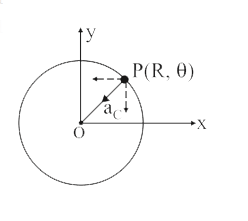In a uniform circular motion, the centripetal acceleration is
Towards the centre of the circular path and perpendicular to the instantaneous velocity
Away from the centre of the circular path and perpendicular to the instantaneous velocity
A variable acceleration making 45∘ with the instantaneous velocity
A variable acceleration , parallel to the instantaneous velocity
The correct Answer is:A
To solve the question regarding centripetal acceleration in uniform circular motion, we can follow these steps:
1. Understanding Uniform Circular Motion:
- In uniform circular motion, an object moves along a circular path with a constant speed. However, its direction changes continuously.
2. Identifying the Type of Acceleration:
- The only acceleration present in uniform circular motion is centripetal acceleration. This acceleration is responsible for changing the direction of the object's velocity while maintaining its speed.
3. Direction of Centripetal Acceleration:
- Centripetal acceleration always points towards the center of the circular path. This is crucial because it is what keeps the object moving in a circular trajectory.
4. Magnitude of Centripetal Acceleration:
- The formula for centripetal acceleration (ac) is given by:
ac=v2r
where v is the tangential speed of the object and r is the radius of the circular path.
5. Characteristics of Centripetal Acceleration:
- Centripetal acceleration does not change the speed of the object; it only changes the direction of the velocity vector. Therefore, it is always perpendicular to the instantaneous velocity of the object.
6. Conclusion:
- In summary, in uniform circular motion, the centripetal acceleration is directed towards the center of the circular path, is responsible for changing the direction of the velocity, and its magnitude can be calculated using the formula ac=v2r.
- In uniform circular motion, an object moves along a circular path with a constant speed. However, its direction changes continuously.
- The only acceleration present in uniform circular motion is centripetal acceleration. This acceleration is responsible for changing the direction of the object's velocity while maintaining its speed.
- Centripetal acceleration always points towards the center of the circular path. This is crucial because it is what keeps the object moving in a circular trajectory.
- The formula for centripetal acceleration (ac) is given by:
ac=v2r
where v is the tangential speed of the object and r is the radius of the circular path.
- Centripetal acceleration does not change the speed of the object; it only changes the direction of the velocity vector. Therefore, it is always perpendicular to the instantaneous velocity of the object.
- In summary, in uniform circular motion, the centripetal acceleration is directed towards the center of the circular path, is responsible for changing the direction of the velocity, and its magnitude can be calculated using the formula ac=v2r.
Similar Questions
Knowledge Check
In uniform circular motion
AAcceleration is constantBMagnitude of acceleration is contantCTangential acceleration is zeroDTangential acceleration is not zeroThe dimensions of centripetal acceleration is
AL2/T2BL2/TCL/T−2D1/T2
In the following questions a statement of assertion (A) is followed by a statement of reason ( R).
A : A uniform circular motion have non uniform acceleration .
R: The direction of acceleration of a particle in uniform circular motion changes continuously .
View SolutionAssertion: A uniform circular motion is an acceleration motion.
Reason: Direction of acceleration is parallel to velocity vector.
View SolutionFor a particle in uniform circular motion , the acceleration →a at a point p(R,θ) on the circle of radiu R is ( Here θ is measured from the x−aξs )
View SolutionAssertion : A uniform circular motion is an accelerated motion.
Reason : Direction of acceleration is parallel to be velocity vector.
View SolutionUniform circular motion is an example of
View SolutionFor a particle in uniform circular motion the acceleration →a at a point P(R,θ) on the circle of radius R is : ( here θ is measured from the x- axis )

View Solution
